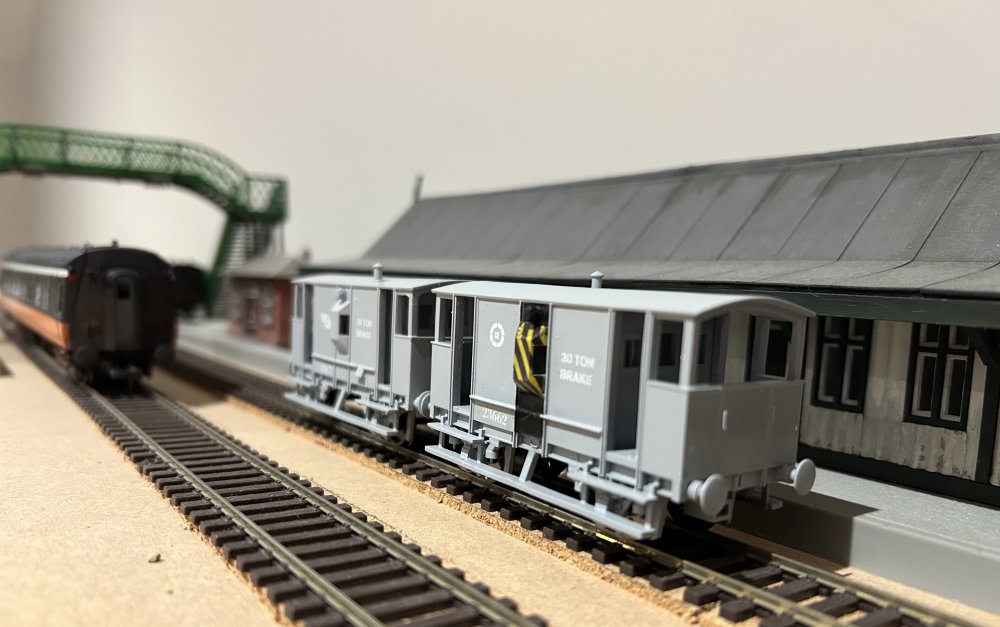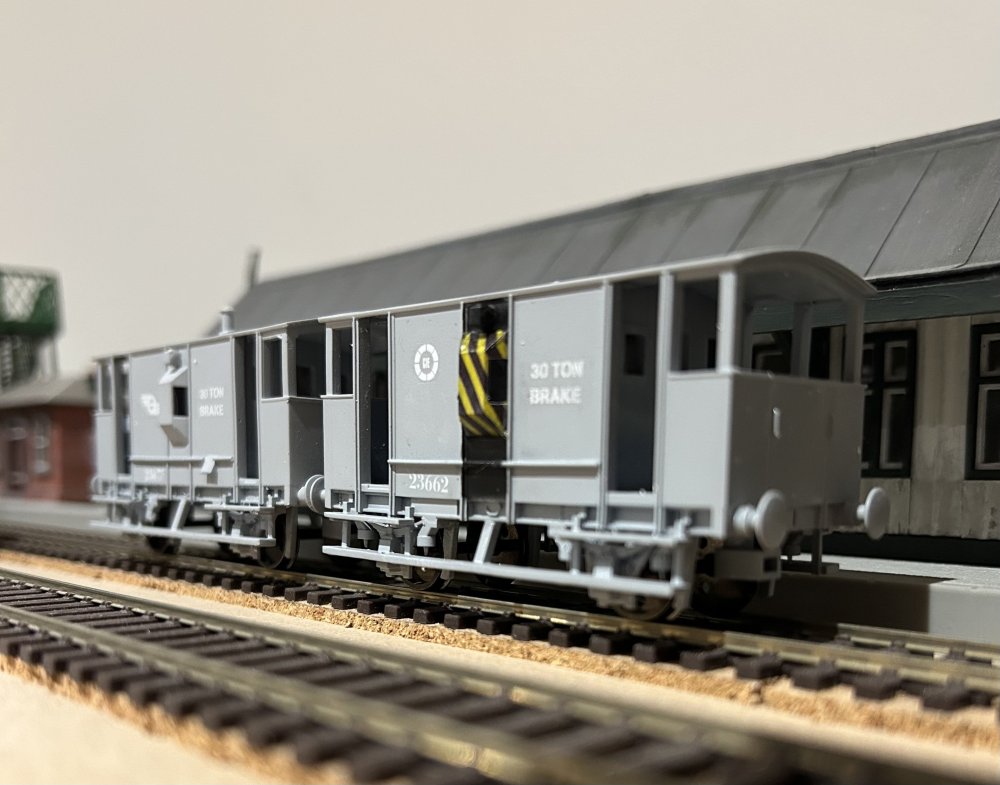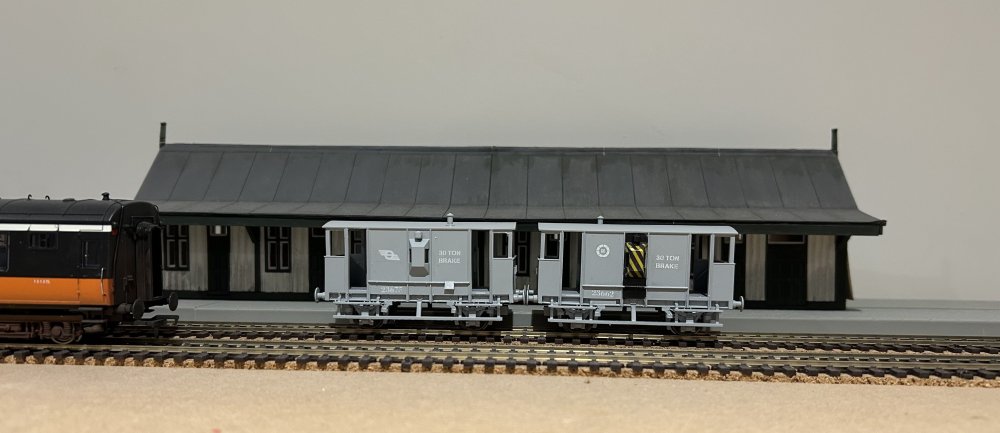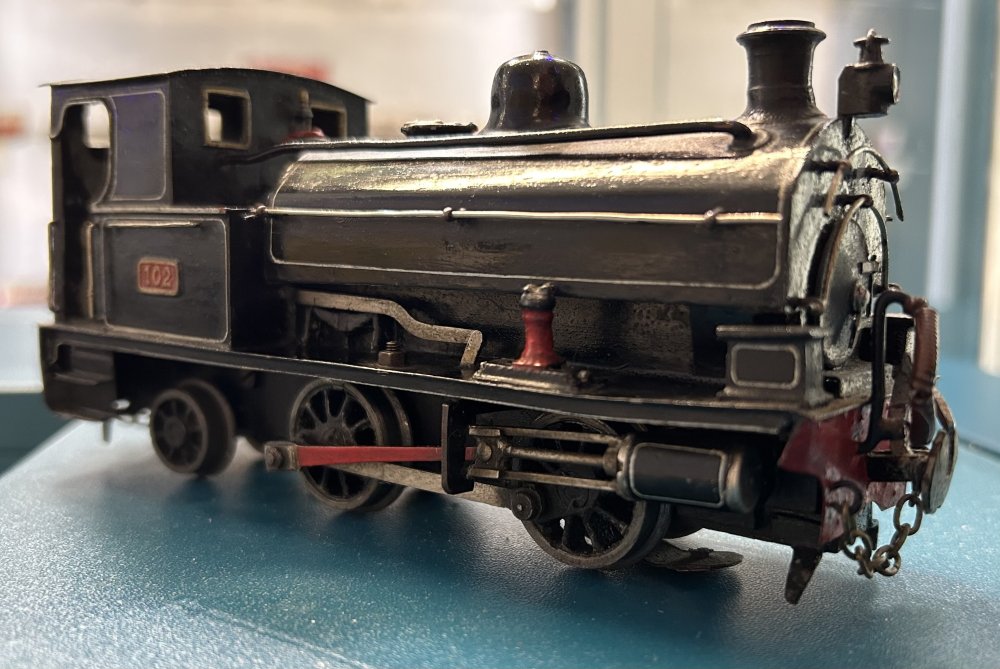-
Posts
15,796 -
Joined
-
Last visited
-
Days Won
393
Content Type
Profiles
Forums
Events
Gallery
Blogs
Store
Community Map
Everything posted by jhb171achill
-
Highly recommended - will spread the word!
-
Yes - maybe two of those put together....
-
Tis de kingdom, boy, all rite! This was my design, built by a gentleman whose name, shamefully escapes me. It is based on a somewhat extended version of that at Kenmare, and obviously bears a very close style resemblance to many in West Cork, and on the Valentia branch. Patrick O'Sullivan's excellent two-part history of the latter branch includes scale drawings of several Valentia line buildings, which provided outline types of dimensions. The corrugated iron sheeting on the sides, unfortunately, is way, way overscale, which has prompted me to eventually build one with scale sized plasticard sheeting, and sell this one. But that's currently way, way down the priority list. I need to do the basic scenery on the area round Castletown West, which after all is meant to be a far more important place than a sleepy Dugort Harbour extension some 4 or 5 miles away. As for Dugort Harbour itself, currently it has no building. I have a signal cabin kit for both, unmade in both cases so far; and I await one of the GSWR footbridges which will hopefully appear for Castletown W. As for Dugort, I had initially intended to do a building there which resembled Westport Quay (platform side) - it actually looked more like a small rural cottage than any sort of railway station. A digression; has anyone ever seen any sort of rural building kit or "RTR" model which looks broadly like that sort of thing?
-
Very nice, and I like the quite ingenious track plan, good for maximum interest in shunting operations at a small terminus like that.
-
Rest in peace, Ian, another stalwart of the tour and enthusiast community lost. I only had the privilege of meeting him once, but a gentleman and great enthusiast.
-
I had the good fortune today to collect two brake vans for the layout. I have two of Mayner's excellent JM design timber-planked CIE standard vans, and two of Leslie's Provincial Wagons old GSWR ones. With a layout based in a time period of mid 1950s to early 1970s, I needed two more at least, so I have added two of the new CKprints CIE standards to the collection. too. This gives an authentic mix of what you'd got about the place in that period. Older ones like the Provincial GSWR ones were still about in very small numbers - the Loughrea and Castleisland branches had the last two in operation into the 70s. Everything else was standard - most steel-sheeted, a few all-wooden, and the odd one like JM Design's "tin" one with planked balconies. As a digression, I MIGHT be wrong on this, but I do think that I once saw a planked one, a la JM Design's earlier example, with a metal sheeted balcony at one end.... but I cam't be certain. Anyway, as you can see, basking in the evening light at a Castletown West station still sparsely endowed with even basic scenery, we see two of CK's vans, designed and produced by Enda Byrne. To say these are SUPERB is an understatement of the highest order. The detail and accuracy is in every way TOP drawer. Very many congrats to Enda for these. I am advised they will be widely available now. I should add, for younger readers, you simply cannot have a goods train of old four-wheel wagons without a brake van. It's like running a train with out track, or without a locomotive, or carriages without wheels. ALL goods trains were loose coupled, meaning that no brake van = no brakes on the train. So, a brake van of some sort is essential. And this type, from about 1960 to the very end of loose coupled trains in the late 1970s, were the most common of all, and in the last few years actually the only types to be seen anywhere but NIR, which retained a few tattered and neglected old vans of GNR & NCC origin for ballast trains. Very highly recommended indeed, and the big news is that Provincial Leslie and CK Enda are now planning future collaborations. All good news for all concerned.
- 11 replies
-
- 19
-

-

-
Absolutely top class job, though to be expected! Here’s Fry’s model of an original Ballycastle engine.
-
All three started life with a unique bluish-tinted green livery, never worn by anythiong else before or since. At the time, every single solitary GSR locomotive was plain unlined grey, even the numberplates. But the 800s were lined as well, in YELLOW and black, and the numberplates and nameplates had a dark blue background (seen on Maedb in Cultra today) and polished numbers and rims. All three received the darker CIE standard green about 1946. Lining in that case was WHITE and black. No. 800 retained dark blue plates, but the other two had their name and numberplates repainted red background, recalling a pre-1915 Inchicore tradition. In all cases, this remained the case until scrapping, except: (1) 802 carried an experimental lighter green 1951-3, but seems to have been repainted normal darker green after that. (2) The livery 800 has in preservation is standard CIE green, not as frequently wrongly stated, GSR livery. It arrived in Cultra without tender markings (a flying snail would have completed that livery authentically), but unfortunately they have put a large "G S" on the tender since iot went in by - presumably to fit in with Cultra's apparent desire to paint things in incorrect liveries, as does the RPSI with most that isn't a GN or NCC locomotive! In later years, colour photos tend to show the green in various guises - this is a mixture fo dirt, uneven weathering, and the actually most frequent misleading thing in old colour photos - the fact that colour emulsions ran and aged differently. When viewing colour pictures in the pre-1975 era, especially if they were originally colour slides, beware! Check with people with a good eye for colour who SAW the thing in real life if possible.
-
During the covid lockdown, before any of these tarriffs and customs charges, from brexit to trump, were started, I was selling off all sirts of old stuff I had (unrelated to railways) on fleabay. I sold loads of stuff. Since then, I am finding that nobody even bids, as the cost of postage / delivery / charges frequently exceeds the value of the item. I've nothing listed right now; it seems to be a waste of time, and much stuff that could otherwise have been turned into cash has gone into the bin. Shame.
-
David's stuff is outstandingly good. Nice guy, too, he used to volunteer with me at the DCDR. I must get him to do one for me!
-
Exactly - hence my advice to make sure first. I have heard of people getting into serious trouble over stuff like this.
-
As far as the actual railway is concerned, you'd probably ned permission to fly directly over their property, but they would have no say outside that. It would be a matter of flying close to the railway line, but not directly over it. Of course, you'd need to be sure that the propety adjacent to the line, where you WERE directly over, would not have issues with it, and obviously also that no legal safety or privacy requirements were breached.
-
Most of the old bogies that survived were corridor GSWR seconds or composites; a few thirds, though the latter were largely concentrated in the Dublin and Cork suburban areas.
-
Was that the Grimes empire?
-
Irish Railway News ‘Enterprise Watch’
jhb171achill replied to IrishTrainScenes's topic in General Chat
What happened? -
There was a tale of an American tourist who had hired an expensive car. He got lost and decided to park somewhere and go to ask for directions. As he parked in a dodgy-looking street, he noticed several dodgy-looking young lads eyeing up the car. He went over to them and said, "Lads, I'm a bit lost here, and I want to go into that shop across the road to get directions. If I'm being honest, this doesn't look like that safe an area. Do you mind me asking if it's safe to park here - like, will this car be here when I come back?" .............. "Jaysus, bud, ye can park that yoke anywhere in Dublin ye like, an' it'll be here when ye come back!"
-
Yes, BnT 141. The Mk 2s on the end were a rare enough type of working and would have been empty. It was not possible to have mixed Mk 2s with any other passenger stock within a train - though the non-Mk 2s were an absolute mix of everything else!
-
Not the place to be political here, but that's the very point I am often at pains to make to today's internet-informed bigots who insist that immigrants have made Dublin unsafe. It's a HELL of a lot safer on the streets at night in almost all areas than it was back then. And it's not people from Somaliastan, Muslimistan and Immigrastan who carry out the vast bulk of what trouble we do have - it's "good ole" white, Dublin-born, 100% Irish! Saw the guards gather up two of them fighting in the street, off their heads on something, only yesterday.
-
Eyyyup lad!
-
The local bears, hyenas, pythons and cheetahs eat them every night, so I'm told............... Recalls to mind, when Senior was a small person, they used to get the train from Dublin to Birr each summer for a week's holidays on my great-aunt's farm, which was near Birr. At Ballybrophy, the station master would be on the platform, bellowing out "CHANGE for Roscrea, Birr and Nenagh!" over and over again. For years, a youthful Senior thought that there was an exotic-sounding place down in the stix somewhere near there called "ROSSgreyburranena"...........!
-
Indeed; what an AI mess! My grandfather would spin like a hi-speed propeller in his grave.......... I'm not seeing the Irish Rail part......? BR livery.....?
-
Utterly ridiculous. Toss those cars into the water, I'd say.
-
And that, in itself, is a scary concept.
.png.c363cdf5c3fb7955cd92a55eb6dbbae0.png)






